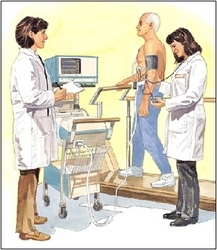Stress Test
An exercise stress test shows your heart’s response to exercise. The test records your heartbeat while you walk on a treadmill or ride a stationary bike. It can be done in a hospital, a test center, or a doctor’s office. The test is also called astress electrocardiogram (ECG/EKG).

Before Your Test
- Be sure to mention the medications you take and ask if it’s okay to take them before test.
- Avoid food and drinks containing caffeine.
- Don’t eat, drink, smoke, or have any caffeine for 3 hours before test.
Getting Ready
- Wear flat, comfortable walking shoes.
- Wear a shirt, blouse, or sweater that you can remove easily. You may be asked to remove your clothing from the waist up. Women may wear a gown.
During Your Test
- Electrodes (small pads) are placed on your upper body and a blood pressure cuff on your arm. These are used to monitor your heartbeat and blood pressure during and after the test.
- You are shown how to use the treadmill or bike.
- You are then asked to exercise for several minutes. Expect the exercise to be easy at first. It will slowly get harder.
- Exercise as long as you can, or until you are asked to stop.
Report Any Symptoms
During the test, be sure to tell the health care provider if you feel any of the following:
- Chest, arm, or jaw discomfort
- Severe shortness of breath
- Fatigue
- Dizziness
- Leg cramps or soreness
After the Test
- You can resume your normal activity.
- The results are sent to your doctor.
- Be sure to keep your follow-up appointment.
